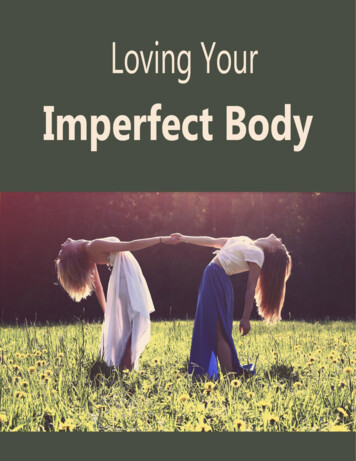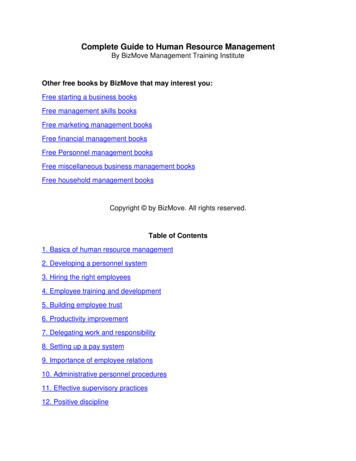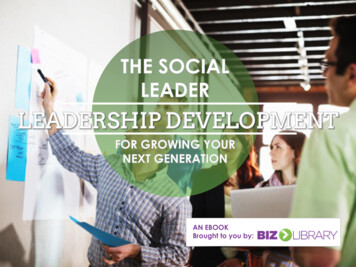
Transcription
Brought to You by Free-Info-Ebooks.comPersonal Use OnlyDisclaimerReasonable care has been taken to ensure that the information presented in this book is accurate. However, thereader should understand that the information provided does not constitute legal, medical, or professional adviceof any kind. No Liability: this product is supplied “as is” and without warranties. All warranties, express or implied,are hereby disclaimed. Use of this product constitutes acceptance of the “No Liability” policy. If you do not agreewith this policy, you are not permitted to use or distribute this product. Neither the author, the publisher nor thedistributor of this material shall be liable for any losses or damages whatsoever (including, without limitation,consequential loss or damage) directly or indirectly arising from the use of this product. Use at your own risk. Note Publisher may receive commissions on promoted products.Related Info ProductsOld School New Body - Turn Back the Years, Visually and HealthThe Smoothie Diet: 21 Day Rapid Weight Loss Program28-Day Keto Challenge - PROVEN health benefits of a Ketogenic DietThe Fat Burning Kitchen - Make Your Body a Fat-Burning MachineKeto Breads & Keto Desserts - achieve better results on the Keto DietBodies smell. They leak. They wrinkle, get blemishes, creak, and ache. They have hairsprouting from weird places, even when hair won’t grow where it’s wanted. Bodies comein all shapes and sizes, all colors, and with all kinds of flaws and differences in ability.And of course, as the children’s book says, everybody poops.In short, all bodies are flawed and imperfect. At the same time, our bodies house ourthoughts, dreams and emotions, and allow us to see, hear, feel, and experience theworld. While there may be a world beyond our physical self, right now, as a living,breathing human, your body is the only home you’ve got. It’s important to love yourhome, even if it’s got a few flaws (which they all do).Our body image influences our self-esteem and self-confidence, affects our physicaland mental health, and changes how we move through the world. If you struggle to loveyour body, read on to learn more about body image and how it can be improved.What Is Body Image?The term “body image” refers to how we feel about our bodies, how we physicallyinhabit our bodies, and how we see ourselves – both in our mind’s eye and when we
look in a mirror. Body image is different than appearance, and in many cases, our ownbody image is quite different than how an objective observer would describe us.A Positive Body ImagePeople with a positive body image have a realistic sense of their own appearance. Theyknow that their appearance does not define their worth as a person, and they are happyand content in their own skin.Having a positive body image does not mean that a person thinks that their body isperfect or without flaws; rather, it means that they understand that everybody has flaws,and is nonetheless deserving of love and respect.A Negative Body ImageIn contrast, people with a negative body image can’t accept their physical flaws. Anegative body image can lead to feelings of shame, or a need to hide. It can keepsomeone from engaging in social activities and can be a barrier to intimacy inrelationships.A negative body image can also lead to people spending excessive time and money“hiding” their flaws with makeup, accessories, or clothing, or seeking out cosmeticprocedures but finding little relief from their appearance-related anxieties.People with a negative body image can become obsessed with perceived flaws that arenot noticeable or only minor to an outside observer. In extreme cases, a negative bodyimage can lead to body dysmorphia, in which someone sees their body as radicallydifferent than it actually is. For example, a body builder with body dysmorphia may seea frail, scrawny wimp in the mirror, even though they are, objectively, built like a tank.A negative body image can lead to poor self-esteem and low-self-confidence, andpeople with a negative self-image are more likely to suffer from poor mental health,including depression and anxiety.While a negative body image isn’t the only cause of eating disorders, it is a contributor.Even in those who do not have full-fledged eating disorders, a negative body image canlead to disordered eating behaviors, including fasting, restricting food groups, dieting,binging, and excessive exercise, all of which can take a toll on health and wellbeing.Worrying about Our AppearanceUnfortunately, today’s society makes it easy to feel bad about one’s body. Even asNorth Americans are getting larger, our image of the ideal body is getting thinner – andharder to obtain. For example, fashion models used to be 8% smaller than the averagewoman, and now they are 30% smaller – and several inches taller.
For men, the physical ideal has also shifted. Just look at the leading men in any Marvelmovie, with their elaborately sculped muscles, as compared to the biggest stars of the1950s. Certainly, celebrities such as James Dean and Marlon Brando were fit andhandsome, but they didn’t spend hours in the gym or eat highly specific diets under thewatchful eye of trainers and nutritionists as today’s impossibly lean and muscular starsdo.Studies show that both men and women are worried about their appearance. Estimatessuggest that around 70% of women aged 18-30 don’t like their body, and around 50%try to control their weight with unhealthy behaviors. Among men, 43% don’t like theirbody and body dissatisfaction is growing among men.A positive body image is important for a happy, healthy, well-adjusted life. A negativebody image harms physical and mental health and can hold us back from achieving ourdreams. Read on for more about how our body image is formed in childhood andadolescence.Body Image in Childhood and the Teen YearsAs infants, our first job is to figure out how our body works. At first, we can’t even lift ourheads, but soon we are crawling, walking, and then running around, getting intomischief. Soon after we start learning to move our bodies, we start absorbing messagesabout which bodies are good, and which are bad. Studies show that children as youngas three may start to worry about their weight.While humans have always valued beauty – a walk through any art gallery will teachyou that – today’s concern about body weight is newly intense and is affecting childrenat younger and younger ages. In 1970, the average age that girls began dieting was 14,but by 1990, that age had dropped to 8. By age 10, more than 80% of girls have beenon a diet.As well as worrying about their own weight, young children also start to judge othersbased on weight. Elementary school students who are obese are 65% more likely tobullied by their peers, and those who are overweight are 13% more likely to be bullied.While children are worried about their appearance at earlier ages than ever before,puberty is still the worst time for liking one’s body. The average person’s body imagehits an all-time low between the ages of 12 and 15, and self-esteem drops along with it.Studies show that by the teen years, many girls will give up many activities such asgoing to the beach, playing sports, or even speaking in public, because of concernsabout their appearance.Along with the decrease in body image during adolescence comes an increased risk ofeating disorders. Most eating disorders begin during the teen years. Even among teenswho do not have a full-fledged eating disorder, unhealthy eating patterns are common.
Half of teen girls and a third of teen boys fast, binge, or use smoking, laxatives orexcessive exercise to control their weight.Evidence shows that media, including movies, television, magazines, and social media,is a big contributor to teen’s body dissatisfaction. Studies show that the more timeyoung women spent on social media, the more likely they are to have a poor bodyimage.When teens read articles about dieting and weight loss, girls are six times more likely toengage in unhealthy eating, while boys are four times more likely. Over 90% of teenagegirls feel that the media pressures them to be thin. While 65% think that fashion modelsare too thin, 46% strive to look like the images they see in fashion magazines.Gender and Body ImageBody image issues affect people of all genders. While many people assume that womenare more affected by messages about their weight and appearance than boys, this ischanging. In the early 1990s, 15% of teenage boys were unhappy about their bodies.This has increased to around 45% today. A recent study of college-age men found thatover 90% of them had at least one part of their body that they didn’t like.In today’s society, boys are caught between wanting to be thinner and wanting to bemore muscular. For that reason, body image issues can show up differently in men thanwomen. Many boys turn to the gym to gain muscle and fall into patterns of disorderedeating and excess exercise. To make matters worse, men are less likely to seek help forbody image issues, even when their health is seriously impacted. Boys and men makeup one third of those with eating disorders, and men and women suffer from bodydysmorphia in equal numbers, but males are much less likely to seek help.For any one of any gender, a negative body image can lead to a lack of self-esteem andself-confidence, and an increased risk of depression, anxiety, and eating disorders. Ifyou aren’t happy with your body, it’s important to know that help is available. If bodyimage issues are seriously affecting your life, talk to your doctor or call the NationalEating Disorders hotline at (800) 931-2237.For more ways to improve your body image, read on.Steps to Overcoming a Negative Body ImageIf you struggle with a negative body image, improving it will also help improve yourphysical and mental health and wellbeing, increase your self-esteem and selfconfidence, and make it easier to developing meaningful connections to the peoplearound you. If you are ready to start improving your body image, there are some toolsbelow that may be helpful.
Recognize That Body Image FluctuatesAs you start on your journey towards a better body image, begin by recognizing thatbody image naturally changes and fluctuates from day to day, and month to month. Itmay take some time to quieten your negative thoughts about your body, and there won’tbe one moment when you are finished developing a positive body image. Doubt andanxiety can always creep back in.It’s important to accept that loving your body is a journey. Understanding this will makeit easier to get back on track any time your journey is derailed.Practice Self-CompassionIt’s hard to maintain a positive body image in the face of a society that emphasizesphysical appearance at every turn through books, media, and interactions amongfriends and family. Fortunately, studies of women show that cultivating self-compassioncan help them maintain a positive body image in the face of negative social pressures.Self-compassion is simply the art of treating oneself with kindness.To build your self-compassion, try reading Self-Compassion by Dr. Kristen Neff, thepsychologist who first established self-compassion as a field of study. The book is filledwith exercises to help you develop your own sense of self-compassion.Cognitive Behavioral TherapyCognitive behavioral therapy (CBT) is a type of therapy focused on helping patientslearn effective strategies for combating negative thoughts and behavior patterns. CBT isone of the most common therapies used to improve body image. In CBT, you will learnto recognize and change the thoughts, emotions, and behaviors that contribute to yournegative body image.If you are interested in trying CBT, the Association for Behavioral and CognitiveTherapies has an online directory of certified therapists.While working with a therapist is the fastest way to learn to control negative thoughtpatterns, there are also steps you can take at home. If you find yourself ruminatingabout your body, try the following: Work through the Body Image Workbook by Thomas Cash. This book offers avariety of research-proven exercises that will help address your own negativebody image. Banish negative body talk. Too often, we criticize our own and others’ bodies.Resolve to stop this negativity. Every time you start to say or think somethingnegative about anyone’s body – your own or someone else’s – stop yourself, andcome up with something positive instead. It may take practice, but if you are
consistent, you will learn to skip straight to the positive thoughts and leave thenegative thoughts behind. Make the mirror your friend. Many of us have a bad relationship with our mirror.We’ll either avoid it entirely, or we’ll use it to stare at our flaws or make faces atourselves. Instead, resolve to treat the person in the mirror with love andkindness. When you see your reflection, look yourself in the eye. Smile. Wave.Say something kind, positive, or seductive. Write yourself positive notes and stickthem in the mirror frame. Whatever you do, don’t allow yourself to frown at yourreflection or criticize your appearance. Practice mindfulness meditation. As little as ten minutes of mindfulnessmeditation each day has been shown to help calm negative thought patterns andboost mood. Meditation can also help you learn to be more present in your bodyand learn to listen to its needs.All you need to get started is a quiet place to sit and a few minutes toconcentrate. There are many free or low-cost meditation apps available for yoursmartphone, or try following along with a beginner mediation video on YouTube.Just find someone with a voice you like and follow their instructions.Boost Your Media LiteracyEvery day, we are bombarded with ads for weight-loss products; articles describingelaborate diet, workout and beauty regimens; and social media posts filled with beautifulpeople with perfect skin and hair. All too often, all three – the ads, the articles, and thesocial posts – are carefully optimized to sell you something.In the case of social media, often what’s being sold is the idea that person in the pictureis beautiful and carefree, regardless of the reality. When you compare your everydayself in the mirror with the perfect photo an influencer just posted, it can be hard to feelgood about your body. However, learning about the various ways in which photos canbe edited, filtered, and manipulated can help you understand the difference betweentruth and reality in images, and it can help you feel better about yourself.To learn more about media literacy and the link to body image, visit About Face, whichoffers online media literacy training aimed at teens (but useful for adults as well). TheCanadian non-profit Media Smarts also offers extensive resources about media literacy,with lessons focusing on food advertising, media and body image, gender stereotypesin the media, and more. In addition, the National Eating Disorders Association alsooffers a media literacy toolkit.Carefully Curate Your MediaEven if you know how media images try to manipulate you, it’s still important to beselective about what information you take in. Support movies, TV shows, magazines
and websites that showcase a diversity of ages, genders, body types, and abilities. Onsocial media, unfollow influencers who make you feel bad about yourself, and seek outvoices who talk about issues that are important to you.Embrace Healthy MovementThe human body is designed to move, and getting regular exercise is one of thehealthiest things you can do for your health, fitness, and mental well-being. If you aren’ta regular exerciser, find an activity you enjoy doing and start doing it.If you are motivated to exercise by setting goals, make sure you set positive goalsrelating to your skills, fitness and enjoyment, rather than goals around losing weight orinches. Good goals include mastering a new skill, running a new distance, or increasinghow much you can lift. Setting healthy, positive goals and watching your body getstronger and more skilled can transform your relationship with your body image.Fitness with a mind-body component such as yoga or tai chi may be particularly helpfulin helping you learn to connect with and appreciate your body. Skills-based exercise,such as Olympic weightlifting, dance, ice skating, rocking climbing, or a new-to-youteam sport can also help boost your body image.When you focus on mastering new skills and observe your slow but steadyimprovement as you keep practicing your chosen sport, you’ll gain a new appreciationfor your body and what it can do.Learn about NutritionGo to any newsstand (or any website) and you’ll see dozens of headlines about everykind of diet under the sun, intermixed with recipes for cookies, cakes, pies and BBQs.It’s overwhelming and confusing. For instance, did you know that Keto, Atkins, Paleo,and low-carb diets are all basically the same thing? If mass media is your only guide, it’shard for the average person to make sense of what to eat. When your diet isn’t optimal,you won’t be as healthy as you could be, and your body image can take a hit.If you are looking for reputable, science-based nutrition information, don’t bother withfashion and fitness magazines. The diet information inside may not be accurate andmay even be harmful. In fact, studies show that simply reading the average fashionmagazine lowers your body image. Instead, visit My Plate, the USDA’s nutrition website.It contains simple advice on eating well.If you still need help, consider visiting with a registered dietitian (RD). RDs will help youunderstand the basics of healthy eating and can teach you how to fuel your body withnutritious, delicious food that helps you be healthy and vibrant.
Live for Today, Not TomorrowIn today’s media-saturated environment, it’s all too easy to fall prey to body imageissues. Over half of all people don’t like some aspect of their body. This has seriousconsequences. A negative body image increases your risk of mental health problems,and it can also hold you back from achieving your dreams and reaching your goals.Many people who don’t like their bodies put off things they’d like to do until they achievethe “perfect body”.The thing is, the perfect body doesn’t exist. Happiness, however, does. If you’ve beenguilty of putting off travelling, going to the beach, or any other activity until you reach acertain body goal, it’s time to stop waiting to be perfect and start living, today. After all,the best way to be happy with your body is to be happy in your body.
Brought to You by Free-Info-Ebooks.com Personal Use Only Disclaimer Reasonable care has been taken to ensure that the information presented in this book is accurate. However, the reader should understand that the information provided does not const










